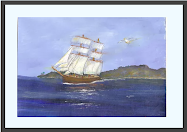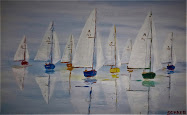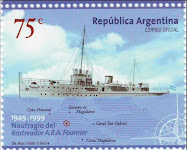Seeadler
This vessel was the only sailing ship to be used as an Armed Merchant Raider, she carried a great deal of mystique that could be owed to her flamboyant Commanding Officer, Felix Graf von Luckner, also known as The Sea Devil. Should you enter into a discussion of this era with anyone with but a passing knowledge of these Raiders, it will always be von Luckner, who is remembered, and spoken about.
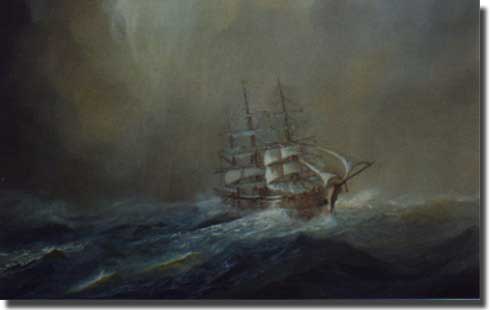
Seeadler painting commissioned by the US Company W R Grace
He was a past master at selling himself and his ship, although Seeadler achieved success, it was not the most successful Armed Raider of WW1, but if her Captain had lived in our present times, I am certain he would have been an exceptional Marketing Director!
Providing coal for the German Armed Merchant Ships around the globe was a daunting task, thus the use of a sailing ship (fitted with a diesel auxiliary engine) would tend to alleviate this problem.
However, the other side of the coin, was the fact that very few German Naval Officers were experienced in sail.
To achieve success in this medium would hinge on first finding, and then selecting the right man, but, one such Naval Officer was von Luckner.
Count Felix von Luckner, 1919, Naval Officer of Seadler 1916 - 1917
He had been born on the 9th. of June in 1881, and had run away to sea as a 12 year old, to serve as a cabin boy in the Russian full rigger Niobe. In pre war days he had sailed at Cowes in England aboard the Krupp yacht Germania, and had seen service in the American Golden Shore, a four masted schooner, and had also sailed in the British Pinmore in 1902, she was another four master. Further experience in sail was gained in the German Caesarea, and the Canadian schooner Flying Fish, thus he had a very reasonable grounding in the art of serving at sea under sail.
Von Luckner had passed examinations for his Mate's ticket, and by 1908 had joined the steamer Petropolis, belonging to Hamburg-Sudamerikanisch, it was his intention to serve for nine months, and then volunteer to serve in the Imperial Navy for a year, and thence to gain his Naval Commission. He was finally called up for the Navy in February of 1912, and was sent to the gun boat Panther.
During the early part of WW1 he was present at the Battle of Heliogoland Bight, and at Jutland he was in charge of a gun turret in the Dreadnought Kronprinz.
It is reported that von Luckner's story telling abilities made him something of a favourite with Kaiser Wilhelm 11, so it was no great suprise that he was appointed Captain of the first sailing ship to be fitted out as a Raider, despite the fact that he was only thirty four years old, and that he had to overcome the raised objections of Senior Officers who thought they were more deserving of this command.
Built on the Clyde in 1888, Pass of Balmaha was owned by the River Plate Shipping Company of New York, and in June of 1915, fully loaded with cotton bound for Archangel, she was stopped by a British patrol north west of Cape Wrath, a boarding party was put on board, and she was ordered to proceed into a Scottish port so that she could be examined.
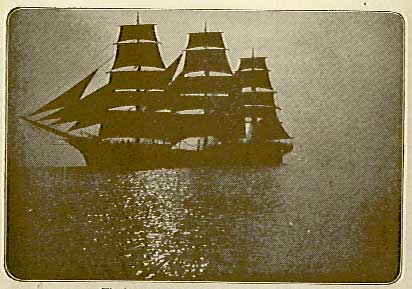
Pass of Balmaha
But before this sailing ship could reach port, a German Submarine U-36, commanded by Kapitanleutnant Graefe seized her, put a Midshipman in command and sent her off to Cuxhaven, with the British boarding party still in her hold. At this stage the ship was named Walter, and the decision was made to convert her into an Armed Raider.
Two 8.8 cm. guns were mounted and hidden behind hinged gunwhales, just aft and behind the forecastle, machine guns were also mountedon board.
The ship known in Naval records as Seeadler or Sea Eagle, had a registered tonnage of 1,571, and fully loaded was 4,500 tons, she was 83 metres long with a 11.8 metre beam, and a draught of 5.5 metres, and under her deisel engine could make about 9 knots. Sails were her main means of propulation, and the force of any available wind would obviously determine her maximum speed at any given time.
At this time in history, there were many sailing ships plying the world's oceans, and the large four masted barques carrying wheat from Australia to Europe still operated until about 1939.
In seeking to disguise Seeadler as a similar Norwegian vessel Maleta. (during my research, I have found this ship sometimes spelt as Maletta, but have chosen to use the form most commonly used.)
With typical German thoroughness prevailing, in von Luckner's cabin, pictures of both the King and Queen of Norway, plus King Edward V11 of England were all featured. Norwegian instruments such as a barometer and chronometer were also in evidence, and a number of his crew could speak Norwegian.
A number of unforseen delays took place, and when the German Maleta was ready for sea, her true sister had sailed from Denmark, and all this planning came to nought.
Another search of Lloyd's Register to come up with a suitable name brought to light, Carmoe, but no one seemed to know where she might be found, but at the last minute, a Norwegian newspaper revealed that the real vessel carrying that name had only recently been stopped and examined by British patrols, once again foiled.
There is some evidence to suggest that von Luckner named his ship Irma, after his fiancee, but the name Hero seems to have been chosen, a Norwegian with a load of timber bound for Melbourne, Australia. Seeadler carrying false papers and a deliberately damaged log book, slipped out of the river Weser on the 21st of December 1916, skirted up the coast of Norway, to then sneak round the tip of Northern Scotland, and run free into the Atlantic.
Within two days, von Luckner and his company of 6 Officers and 57 other men, were coping with a howling gale, at least it helped to explain the soaked state of his log book etc, should they be stopped by a British blockade ship, and subsequently boarded for a routine inspection.
As part of the ploy to convince any British boarding party that his ship and crew were Norwegian, von Luckner had a slim young sailor masquerade as his wife, complete with a suitable blonde wig.
Come Christmas Day 1916, Seeadler having battled the elements for three days was south west of Greenland, when out of the rain a large ship appeared, it turned out to be the British 15,000 ton Armed Merchant Cruiser, Avenger, she immediately signalled the sailing ship to heave to, and await its boat carrying an inspection party.
All went well, and his ship's disguise proved successful, but at the last moment, as the two British Officers were about to leave the scene, von Luckner noticed with some trepidation that the Seeadler's propellor was very evident. His ship was purporting to only be a simple sailing vessel, so thinking and acting very quickly, von Luckner grabbed a rope and swung it towards the British boat, so that they could pull themselves forward. This distraction caused the Officers to focus their eyes on this rope, saving any embarrassment, and the propellor remained a secret.
Now the timber deck cargo covering up the hatches was ditched over the side, and Seeadler assumed her true role as a German Raider.
On the 9th of January 1917 von Luckner came upon a black hulled, single funeled steamer. He now hoisted a request for a time signal, not an uncommon proceedure from a sailing ship that had been out of sight of land for some time, and wished to fix her position. Many steamship Captains, having served their time in sail would welcome the opportunity to view close up a fine clipper ship under press of a full suit of sails.
Then, too late, Seeadler would announce her true identity by running up the German Naval Ensign, and firing a warning shot to stop her intended victim. The ship in sight proved to be the 3,268 ton Gladys Royle, a British vessel loaded with coal, out of Cardiff and bound for Buenos Aires.
A shot was fired across her bows, a second shot followed the first, then a third passed over the funnel, it was enough, and Gladys Royle quickly hove to, and a German boarding party laid and fired scuttling charges, and the ship slowly sank stern first. The crew were taken onboard Seeadler.
The next day another steamship, unnamed, and not flying any flag, crossed ahead of Seeadler, whose question "What Ship?" remained unanswered, von Luckner now steered his ship across the steamer's bows. Under the International Rules of the Road at Sea, steam gives way to sail, but notwithstanding this rule, von Luvkner was forced to take avoiding action as the steamer simply ignored him. and steamed resolutely on.
The German Ensign now fluttered to the masthead, and a shot was fired across the bows of this recalcitrant ship, but the Captain of the 3,095 British Lundy Island, remained stubborn, he reasoned that by steaming directly into the wind, he could outrun this German sailing ship beating up into the wind.
Seeadler now took up this challenge seriously, and opened fire with real intent to stop her quarry, the funnel was pierced by a shell, one burst on deck, and a further two shells entered through the hull. The struggle was over, the steamer lowered boats and hove to, von Luckner ordered the British Captain to come onboard his ship, but he was totally ignored, so off went a German boarding party to investigate. It appears that British Lundy Island carried a cargo of sugar from Madagascar, it was thought that this was too valuable a cargo to quickly surrender to a mere sailing ship, hence the decision to try and outrun Seeadler.
When the first shells struck home, the crew rushed to the boats leaving their Captain to take the wheel himself, but the rudder chain had been parted by an incoming shell, leaving the ship to wallow helplessly.
Captain Bannister was left alone on board as his crew abandoned ship.
Later, Bannister told von Luckner he had previously been captured by the German Raider, Mowe, and had been granted parole, which he had broken, he was thus not too keen on becoming a Prisoner of War for the second time.
Von Luckner continued his journey southwards, and by the 21st. of January was in the middle of the Atlantic Ocean, level with both Brazil and West Africa.
The French 2,199 ton, three masted barque Charles Gounod, loaded with corn for Bordeaux was intercepted and scuttled. From the Frenchman's Log Book, information was gleaned about sailing ships she had met, and their intended routes.
It was necessary for a ship like Seeadler to seek out, and gather information of the whereabouts of possible victims, from whatever source she could, and captured documents from ships met, and sunk, proved invaluable. Von luckner's command, unlike her fellow Raider, Wolf, did not carry a seaplane that could extend her horizon. The ship's radio was not as advanced as this equipment had become by the time that the Raiders of WW2 were let loose on the world's oceans, to prey upon Merchant Ships carrying goods on outwards journeys to America, and the Empire, and essentials, particularly food stuffs on the return trip to Britain.
On the 24th. of January, Perce, a small 364 ton three masted schooner from Canada was met, her crew including the Captain and his new bride were taken aboard Seeadler, and gunfire was used to quickly sink her.
Another sailing ship was sighted on the 3rd. of February, and it proved to be the French four masted 3,071 ton Antonin loaded with saltpetre from Chile. Although Seeadler's diesel engine was not operating, she proved to be the faster ship under sail, and the Frenchman was very soon overhauled.
Machine gun fire ruined her sails, she stopped, and hove to, her crew were taken aboard the Raider, and scuttling charges quickly sank this proud vessel.
Now on the 9th. of February, an 1,811 ton sailing ship Buenos Ayres from Napoli, again loaded with Chilian saltpetre was met and despatched.
Ten days later Seeadler sighted a four masted barque which immediately crammed on more sail, and started to draw away from the German, but now aided by the diesel auxiliary engine which was in working order again, the Raider commenced to gain on her target. When ordered to state her name, this ship responded with Pinmore, she was a 2,431 ton ship, her cargo, grain, her Captain, James Mullen.
This British ship built on the Clyde in 1882 and registered in Greenock, Scotland, and now owned by Tridonic Limited, had, by coincidence been home for von Luckner, back in 1902 during his merchant ship days.
The German Captain now took Pinmore into Rio de Janeiro for supplies, and according to his memoirs, he bandaged up his hand, so that he could avoid having to sign any customs documents as Captain Mullen.
It is suggested that this claim, like many of the flamboyant von Luckner's yarns proved to be somewhat far fetched, as Captain Mullen was very well known in Rio.
Eventually scuttling charges were used to sink this British ship.
The next ship to be stopped was the Danish barque Viking, but as her cargo was untoward, she was released and allowed to proceed unmolested.
On the 26th. of February, Leutnant Preiss sighted a ship looming out of the morning mist, after closing for 15 minutes, it proved to be the British 1,953 ton threemaster barque British Yeoman. She had sailed under the Red Duster prior to 1916, being registered in Vancouver British Columbia, but her new owners were American. Captain Armstrong asked for news of the war, and von Luckner said he would signal all this information, and promptly hoisted three flags C I D, their meaning, "Stop immediately or I will fire."
The boarding party found a cargo which included live chickens and pigs, all of which were quickly transferred to their new owners, a most welcome addition to by now, a very mundane diet, after being at sea for some time. Scuttling charges sank British Yeoman, some distance off the Brazilian coast.
Seeadler was making her presence felt on these trade routes where sailing ships plied, but, although she had sunk 7 ships, their total tonnage was not really significant. A great deal of effort for a relatively little return.
That same evening, a light astern slowly revealed a large four masted barque, but von Luckner maintained a position ahead of this ship until at dawn she could be identified as the French Le Rochefoucauld. Seeadler now signalled, "Stop! We have important news." The Frenchman naturally very obediently slowed down, only to be met with unmasked German guns, and a German Ensign suddenly in view at the masthead, too late she understood that she had been outwitted by von Luckner and his ship.
The boarding party discovered that the French ship had only recently been stopped by a British Cruiser, and that the French Captain had ordered this record be removed from his Log, in the hope that this Cruiser might catch Seeadler unawares, as her presence in the area was well known.
The French barque was sunk on the 27th. of February.
By the evening of the 5th. of March, Seeadler had moved far enough southwards to raise the Southern Cross, a stellar constellation that confirms to anyone at sea that they are now sailing well below the equator.
The German ship now found a four masted barque standing out against the moonlight, von Luckner, using a signal lamp told the barque to "Stop immediately! German Cruiser."
Now a quite bizarre incident took place, the French Captain rowed across to Seeadler, convinced that another French vessel was playing a practical joke on him, this was only a hoax, but to both his suprise and chagrin, he suddenly found himself the prisoner of a German Naval Officer, and his command Dupleix, of 2,206 tons about to be sunk.
The next victim found by Seeadler on the 10th. of March, was asked to pass the chronometer time, but this signal was ignored, so von Luckner ordered a smoke generator to be ignited, and so simulated a fire was burning in his ship. The Horngarth of 3,609 tons, its large stern gun very much on view, now turned back to render assistance to this burning sailing vessel.
Von Luckner acted quickly, up went the German Ensign, and a single shot from the 8.8cm.gun put the British ship's radio out of action. The boarding party set, then exploded scuttling charges, by this time they were most experienced in quickly blowing up captive ships, Horngarth's crew were embarked aboard the Raider.
The German Captain was now faced with the same problem that his counterparts encountered in WW2. What to do with the increasing number of prisoners now on board? Almost 203 of them needing to be fed daily, and safely housed on board.
Another 10 days brought a solution in the shape of the French four masted barque Cambronne, of 1,863 tons. But the prisoners and their disposal still posed their own set of problems, it was not practicable to release a sufficient number of German sailors to sail Cambronne to a position where von Luckner wanted her to proceed. If he merely put his prisoners aboard, and then released this ship, she would most likely sail to the nearest port to alert the world at large about Seeadler, her position, and her recent exploits. This dilemma was solved by removing the top gallant masts from the Frenchman, and destroying any spars and sails. These actions ensured it would allow sufficient time for Seeadler to clear the area and make good her escape.
Captain Mullen ex Pinmore was placed in command of the Frenchman.
The Royal Navy were aware of the presence of the German ship in the general area where she was operating, and the Armed Merchant Cruiser, Otranto, plus the Cruisers Lancaster, and Orbita were all set to spring the trap on Seeadler as she rounded Cape Horn.
Von Luckner pausing in his rush for Cape horn, went off to the Falklands, threw overboard a large metal Iron Cross in memory of Admiral von Spee and his men who perished there in the Battle of the Falkland Islands in December of 1914.
Whilst earlier to this engagement, von Spee had been successful against the British Admiral Craddock at Coronel.
Seeadler now ran into hurricane conditions, and was forced well south of the Horn before moving into the Pacific on the 18th. of April, the bad weather had actually proved to be a boon for von Luckner, as he thus escaped the British net, and now sailed northwards along the coast of Chile.
During this time of inactivity, von Luckner ordered property taken from his prisoners to be thrown overboard, and he ensured these were all marked with the name Seeadler, the obvious inference being that his ship had been sunk. There seemed to be no end to the fertile imagination of this audacious German Naval Officer, who continued to scheme, and seek out new ways to exploit his role as an Armed Raider loose on the high seas.
The British also played games, in an apparent attempt to restore confidence to ships sailing and trading in this arena, they broadcast a message "Seeadler gone down with all flags flying, Commander and crew taken prisoner and now on their way to Montevideo." Or had some of the cast aside gear from Seeadler been recovered by the Royal Navy? and they were trying to exploit the situation regarding the doughty von Luckner and his ship. From this distance in time, it may appear that these actions were somewhat childish but, one cannot know what effect it had at that time on the various players in this drama of the sea.
By early June, Seeadler was eastwards of Christmas Island, and now learned that the United States had joined in the war.
Von Luckner's next victim was the 529 ton four masted schooner A B Johnson from San Francisco, she was destroyed by fire on the 14th. of June, and on the following day, R C Slade, another American four master of about 673 tons met a similar fate, yet one more small American schooner Manila, on the 8th. of July was sent to the ocean floor.
Some 29 prisoners including one woman were now on board, they needed feeding, exercising and in general looking after, the role of the Raider's crew could so quickly change. At one moment they are called upon to fight, and maybe put their lives at risk, then after a successful engagement, when the target crew have been taken onboard, their role changes to one of nursemaid.
It has always been a suprise to me, and somewhat of a mystery, how individual Armed Merchant Ship crews could be kept motivated over long spells at sea, thousands of miles from home and loved ones, the dull, daily routine, with an endless horizon stretching in all directions, with but the rolling sea in sight. How did Captains and Officers keep themselves ready at all times? let alone their crew?
I do not profess to know the answers to my own questions, was it possibly in the type of people selected to be a crew member aboard one of these ships? Was it a love for and of the Fatherland? or pure parriotism? I do not know, and of course I digress!
After several weeks of fruitless cruising along the Doldrums, Seeadler was well overdue to be laid up so that her fouled bottom might be scraped clean again, so she put into Mopelia Island, about 450 kilometers from Tahiti, this circular atol was some 10 kilometers in diameter, and had a deep sheltered lagoon. But, Seeadler was forced to anchor outside the reef, as the water was too shallow to allow her to make a pasage into the shelter available inside the lagoon.
On the 2nd. of August, disaster struck!
If one accepts von Luckner's account of events, this is what happened.
"At about 0930 (9.30 AM) he had noticed a strange bulge on the eastern rim of the sea.... at first we thought it was a mirage. But it kept growing larger. It came towards us. Then we at last recognized it... A TIDAL WAVE, such as is caused by a submarine earthquake and volcanic disturbances.
"The danger was only too clear. We lay between the Island and the wave. We dared not raise sail, for the wind would drive us onto the reef. So, our only hope of getting clear of the Island was on our motor. The huge swell of the tidal wave was rushing towards us with breakneck speed. The motor did not stir. The mechanics worked frantically. They pumped compressed air into the engine. We waited in vain for the sound of ignition.... by this time the oncoming tidal wave was only a few hundred yards away. We were lost."
The force of the water carried Seeadler bodily onto the reef, she was dismasted, and her hull broached by huge lumps of coral. She became a total wreck.
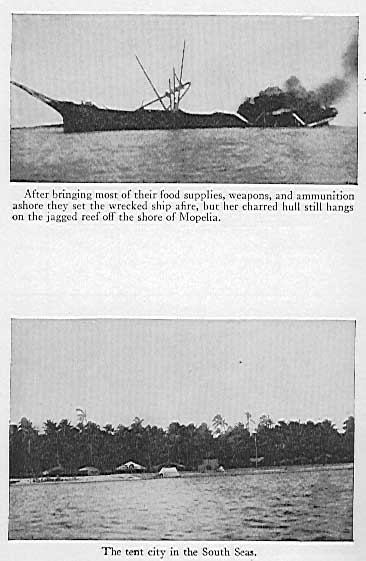
There have been conflicting reports of what actually happened to von Luckner's ship, some American prisoners claim the ship ran aground onto the reef whilst the majority of her crew and the prisoners were picnicing on the Island.
Tidal wave records make no mention of such activity around August of 1917.
Whatever one accepts as the truth is of no great consequence, all the crew and their prisoners survived, but were now stranded on Mopelia Island.
The crew salvaged what they could from the wreck, two of the ship's boats were still intact, some provisions and firearms were collected.
Von Luckner now decided to take 5 crew, his Navigator Leutnanmt Kircheiss, Engineer Krause and three seamen, in one of the 10 metre lifeboats, rigged as a sloop, and rather ironically named Kronprinzessin Cecile, after a former trans Atlantic liner of that name. He proposed to sail via the Cook Islands to Fiji, capture a sailing ship, return to Mopelia for the rest of his crew, and the prisoners, and then resume his raiding activities, he was forever "The absolute optimist."
So, on the 23rd of August, this intrepid band set off, three days later reaching Aitu Island in the Cook Group, pretending to be Dutch - American seamen trying to cross the Pacific Ocean to win a bet. The New Zealand Resident provided the group with enough fresh supplies to carry them onto another island in the Cook Group, Aitutaki. Here they posed as Norwegians, but this time the New Zealand Resident was very suspicious, but he had no means of arresting or detaining von Luckner and his five companions, and the German Captain reading the situation, decided to quickly exit this port, and sailed on to Rarotonga.
The approach to Rarotonga harbour was made in darkness, there at anchor, without lights was what appeared to be a large ship, looking very like an Auxiliary Cruiser. Von Luckner was alarmed, was this ship waiting to trap them? He was not going to wait, quickly turning Kronprinzessin Cecile about, he sped off for Fiji.
The supposed Auxiliary Cruiser, was in fact, the run aground Maitai, not at all posing a threat to the German sailors.
By the time they had raised the Fijian Island of Wakaya, and anchored, the group were exhausted, they had traversed some 3,700 kilometers of lonely ocean in an open boat, a commendable feat of endurance and seamanship skills.
The people here seemed to swallow the yarn that they were shipwrecked Norwegian sailors, but not one sceptic, named McPherson, he set off for the police station at Levuka, it had been the old capital of Fiji, prior to the British using Suva as their administrative centre.
Sub Inspector Hills with a party of Fijian policemen manned a cutter and set out to investigate this strange group that had suddenly arrived at Levuka. Bad weather forced them back to harbour, but the German group would have had little trouble in coping with Hills and his party.
Now by chance, the inter-island steamer Amra arrived at Levuka, it was requisitioned by Hills, and sailed for Wakaya arriving close to daylight on the morning of the 21st of September.
Hills called on von Luckner and his men to surrender, bluffing that the gun on board Amra would blow them out of the water, not wishing to cause any bloodshed, the German Captain decided that for his men and himself the war was over. It was only later that he learned that Hills had tricked him into this surrender, Amra did not mount any guns at all, for this sailor who had lived by his wits and bluff for so long it must have been a sad and bitter moment.
Now whilst von Luckner and his five men were enroute to a Prisoner of War Camp on Motuihe Island near Auckland New Zealand, back at Mopelia Island, the small French Island Trader Lutece, anchored off the reef. Leutnant Kling from Seeadler had learned by radio that his Captain had been captured, now rowed out to this schooner and captured her at gunpoint.
A deed worthy of his swashbuckling Captain von Luckner.
The crew of Lutece were quickly put ashore to join the American prisoners, and all the German sailors went aboard, and course was set for the west coast of South America.
The boat left behind by Kling was now sailed by the Master of A B Johnson, Captain Smith, and three American seamen some 1,600 kilometers to Pago Pago, arriving on the 4th of October 1917, here, they were able to alert the authorities all about the exploits of Seeadler, and to report that forty four sailors were still stranded at Mopelia Atol.
But back to Kling, hoping to refit Lutece, now renamed Fortuna, at Easter Island, prior to attempting to round Cape Horn, this vessel now ran into uncharted rocks off Easter Island, and sank. All the German sailors scrambled ashore to be collected by Chilian authorities and be interned for the remainder of the war.
Although it appeared that the war had ended for von Luckner, still he plotted. The Commandant of the prison camp, Lieutenant Colonel C. Harcourt Turner, could communicate with the mainland by telephone, but also at his disposal was a fast motor boat Pearl. With Leutnant Kirscheiss and a few other prisoners, von Luckner, on the 13th of December grabbed Pearl and sped off to freedom, making for Mercury Island close to the tip of the Coromandel Peninsula.
This motor boat was fitted with a dummy machine gun and then von Luckner boldly stopped Moa, a 90 ton scow owned by Leyland O'Brien Timber Company, she was only carrying the Master and four other men, Moa was boarded, von Luckner indicating "You are Prisoners of War to Germany."
Up fluttered the German Ensign, and they set off for Kermadec Islands, north east of New Zealand, reaching this destination in five days.
Pearl which was being towed, was suddenly swamped by an inrushing wave, she quickly sank, taking the very valuable radio with her to the bottom of the Pacific Ocean, thus depriving von Luckner of his major source of information.
At the time of seizing Moa, she had been close to another scow Rangi, her Captain had observed a party board Moa from a boat, and then noted that she sailed off away from New Zealand. He took his ship into Port Charles to report his suspicions.
It so happened, that an hour later, the government cable layer Iris, armed with two six pounder guns arrived on the scene, having been given the story about Moa, she set off in pursuit, rightly assuming that Moa would make for the Kermadec Island group.
On the 21st of December, Moa made it to Curtis Island in the Kermadec group, and von Luckner sent off a boat to raid the stores depot that he knew was there.
Smoke now appeared on the horizon, sail was quickly raised, but in ninety minutes Iris overhauled Moa, and firing shots across her bows brought von Luckner to once more surrender.
As he came aboard Iris, he commented " You left the door open, you cannot blame me for walking out!"
At last, this time the war really was over for this wily German Naval Officer, von Luckner had indeed put up a good fight. He spent the remainder of the war in various prison camps around New Zealand until he was repatriated to Germany in 1919. In the mid thirties, von Luckner sailed around the world in his private yacht Vaterland, and when he visited New Zealand , was very warmly welcomed. During WW2 he lived in Germany, and moved to Sweden, dying there in 1966.
He lived an adventurious life, grabbing every day by the scruff of the neck to extract the utmost from his environment. von Luckner served his country, and his Navy well, he was a man for his time, and it is unlikely that we will ever witness the likes of "The Sea Devil "again, it is now a totally different world that we all live in today.
See also "The Search for Count von Luckner" by HL Dixon and "Life as von Luckner's Prisoner" by C Singer

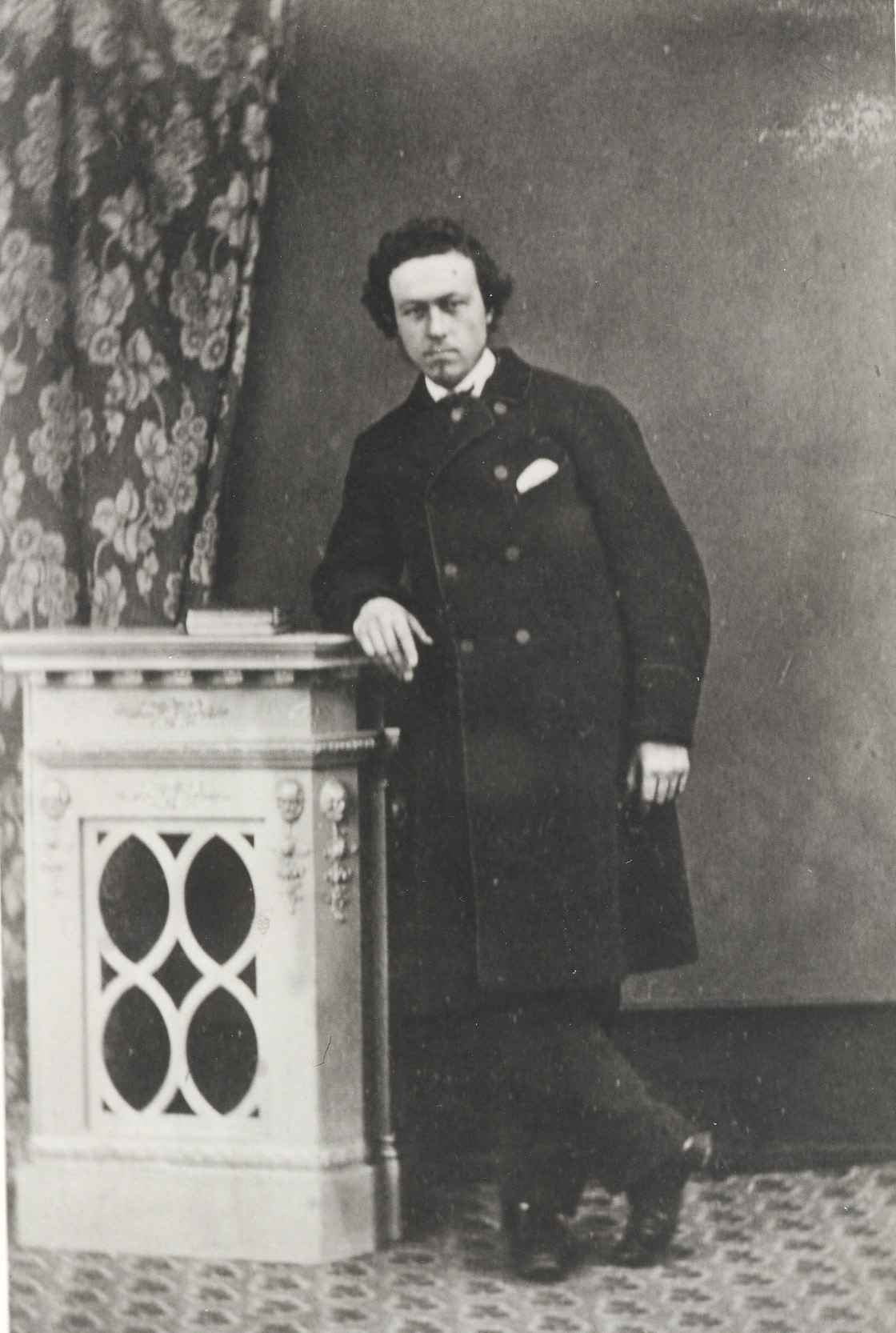



 After arriving at Shanghai in late May 1872, she met the Thermopylae when loading her tea cargo. With both sailing from Woosung on 17th June 1872, the two ships closely matched each other through the China Sea and into the Indian Ocean. By 7th August, and with a good tail wind, the Cutty Sark found herself a good 400 miles ahead of the Thermopylae. On 15th August, disaster struck when the Cutty Sark’s rudder gives way. After reconstructing the rudder twice in heavy seas, the ship arrived back at London on 19th October, around 7 days after her rival. The courage and determination of Captain Moodie and his crew won the Cutty Sark great credit, but Moodie retired from his command of the ship due to stress and the ship was never to get this close to winning the tea race again.
After arriving at Shanghai in late May 1872, she met the Thermopylae when loading her tea cargo. With both sailing from Woosung on 17th June 1872, the two ships closely matched each other through the China Sea and into the Indian Ocean. By 7th August, and with a good tail wind, the Cutty Sark found herself a good 400 miles ahead of the Thermopylae. On 15th August, disaster struck when the Cutty Sark’s rudder gives way. After reconstructing the rudder twice in heavy seas, the ship arrived back at London on 19th October, around 7 days after her rival. The courage and determination of Captain Moodie and his crew won the Cutty Sark great credit, but Moodie retired from his command of the ship due to stress and the ship was never to get this close to winning the tea race again. Cutty Sark successfully collected her last Chinese tea cargo in 1877. In December of that year, the ship departed London bound for Sydney for a coal cargo, and then went onto Shanghai. Arriving at China in April 1878, the ship’s master, Captain Tiptaft, could not consign a tea cargo. By this time, steam ships had taken over this trade.
Cutty Sark successfully collected her last Chinese tea cargo in 1877. In December of that year, the ship departed London bound for Sydney for a coal cargo, and then went onto Shanghai. Arriving at China in April 1878, the ship’s master, Captain Tiptaft, could not consign a tea cargo. By this time, steam ships had taken over this trade.  The crew, incensed, downed tools and refused to work resulting in most of the sailing being done by the six apprentices and four tradesmen. On 5th September the ship was becalmed in the Java Sea for three days. With the guilt, calm, steaming heat and realisation that his career was finished, Wallace jumped overboard. Although a rescue attempt was mounted, the only sign of Wallace was the number of sharks swimming furiously about…
The crew, incensed, downed tools and refused to work resulting in most of the sailing being done by the six apprentices and four tradesmen. On 5th September the ship was becalmed in the Java Sea for three days. With the guilt, calm, steaming heat and realisation that his career was finished, Wallace jumped overboard. Although a rescue attempt was mounted, the only sign of Wallace was the number of sharks swimming furiously about…
 By January 1922 Ferreira ran into a Channel gale, and the captain put into Falmouth harbour to repair the damage. Wilfred Dowman, a retired windjammer skipper and owner of the training ship Lady of Avenel, saw the ship and set out to buy her. However, she returned to Lisbon without further mishap and was sold to a new Portuguese owner who changed her name to Maria do Amparo. But Dowman still wanted the ship, and at a price of £3,750 (more than what she was worth even in 1895) it was brought back to Falmouth.
By January 1922 Ferreira ran into a Channel gale, and the captain put into Falmouth harbour to repair the damage. Wilfred Dowman, a retired windjammer skipper and owner of the training ship Lady of Avenel, saw the ship and set out to buy her. However, she returned to Lisbon without further mishap and was sold to a new Portuguese owner who changed her name to Maria do Amparo. But Dowman still wanted the ship, and at a price of £3,750 (more than what she was worth even in 1895) it was brought back to Falmouth. 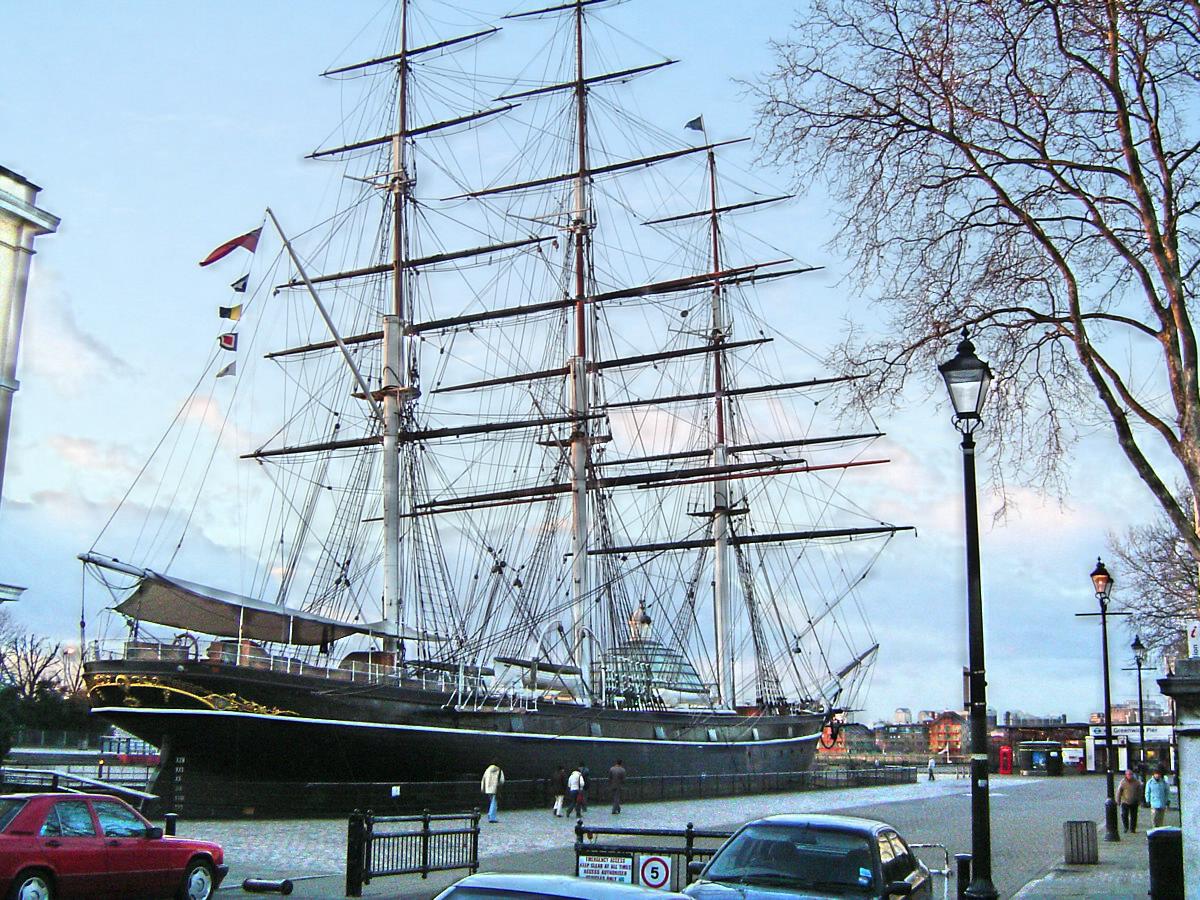 Since her official opening in 1957 by HM The Queen (broadcast live on the BBC), Cutty Sark has been visited by over 15 million people from all over the world. Now, over 135 years after her launch (long since outliving her life expectancy of just 30 years), she is in urgent need of conservation. Keep checking the website for updates on the Cutty Sark Conservation Project, and from Spring 2007, a temporary visitor facility will be open, explaining why we are conserving the ship and the process of conservation.
Since her official opening in 1957 by HM The Queen (broadcast live on the BBC), Cutty Sark has been visited by over 15 million people from all over the world. Now, over 135 years after her launch (long since outliving her life expectancy of just 30 years), she is in urgent need of conservation. Keep checking the website for updates on the Cutty Sark Conservation Project, and from Spring 2007, a temporary visitor facility will be open, explaining why we are conserving the ship and the process of conservation. 

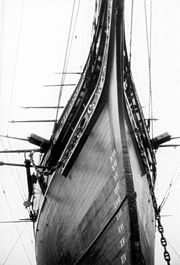










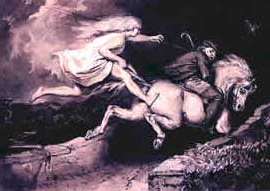














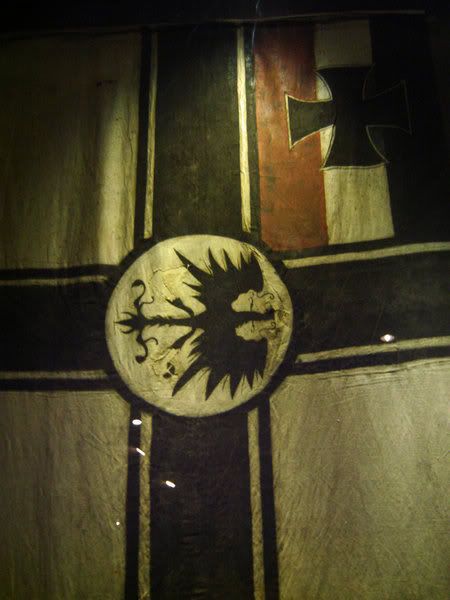






 Felix Count von Luckner: Biography
Felix Count von Luckner: Biography

